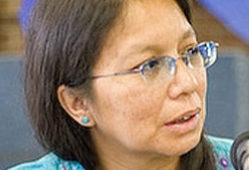Mercury-blighted community of Grassy Narrows takes its case to the UN

Delegation of indigenous Canadians presenting its case in Geneva for safe drinking water for community first poisoned in the 1960s
By Jim Coyle Toronto Star
By any measure, it’s a long way from Grassy Narrows First Nation in northern Ontario to a United Nations proceeding in Geneva. But Judy Da Silva long ago proved she’ll go to any lengths for her people and the generations to come.
“I didn’t really know what to expect,” said the 54-year-old mother of five, part of a delegation of indigenous Canadians making presentations to a UN committee this week.
“As the days went by, I started understanding how high that forum is! Our message came out really strong as the indigenous people.”
Da Silva took her community’s case for safe drinking water to the UN Committee on Economic, Social and Cultural Rights, arguing that Canada had violated those rights by failing to address mercury pollution in Grassy Narrows.
Canada signed the UN Covenant on Economic, Social and Cultural Rights in 1976. The UN monitors performance by summoning signatory nations for periodic review. Canada was last reviewed in 2006 and this year was up again.
It’s a long way to go for justice. And, since the mercury that poisoned Da Silva’s community was discharged into the English-Wabigoon River system from a pulp and paper mill a half-century ago, it’s a long time to wait.
In the 1960s, about nine metric tonnes of mercury was discharged upstream from the reserve. It contaminated the water and the fish that were a food staple and supported a commercial fishery.
A range of debilitating illnesses began showing up in the community, including brain damage, loss of vision, speech and hearing, numbness, tingling and skin irritations.
The contamination came to light in the 1970s. And ever since, residents there have lived with mercury’s horrible legacy. They don’t believe the fallout in their community has been adequately acknowledged or addressed.
In a submission to the UN committee, the Grassy Narrows council — representing about 1,500 people, some 950 of whom live on reserve — said mercury persists to this day in river sediment and continues to be taken into the food chain.
Deputy Chief Randy Fobister was born and raised in Grassy Narrows. Mercury has been the story of his lifetime. “It’s a long time,” Fobister told the Star. “And it’s still going.”
At 46, he’s part of the latest generation of leadership seeking redress for the poisoning of the waters.
The river system was “the lifeblood of our people,” he said. Fishing provided food, employment and was part of the “culture of our people.”
But after the mercury was dumped, the same waters that brought nourishment carried tragedy and “a severe health crisis in our community.”
From Geneva, Da Silva told the Star some progress has been made under the Ontario government of Premier Kathleen Wynne.
“It’s not that nothing’s going on. The government is actually meeting with us. But it feels like butting heads a lot of time.
“So far, it’s (been estimated it would run) about $120 million for river cleanup. And I feel like it’ll never happen. But that’s something that needs to happen if our kids are going to stop getting sick.”
Da Silva’s activism runs deep. She met her husband at the Earth Summit in Brazil in 1992, campaigned against nuclear waste disposal and clear-cut logging in the north, and got involved when it was discovered 20 years ago that mercury was still in the water.
Now environmental health co-ordinator in Grassy Narrows, she said there’s optimism at the election of a new federal government promising improved relationships with First Nations.
No government has ever fully acknowledged the mercury poisoning, she said. No one has apologized.
While Da Silva was in Geneva, Wynne apologized this week in the legislature for a 1912 regulation that effectively outlawed public French-language education in primary schools for more than a decade.
“That’s one of our six original demands that we put out was asking for an apology,” Da Silva said.
“It seems very difficult for them to even do that.”









It’s high time that the government takes ownership of this atrocity and cleans up their mess.
It’s been ignored long enough already!